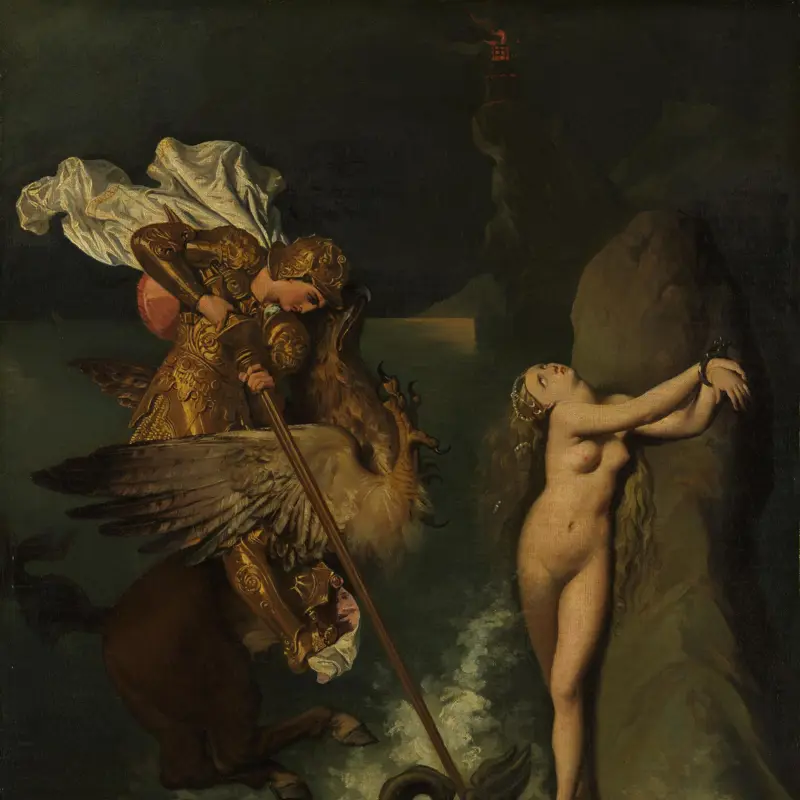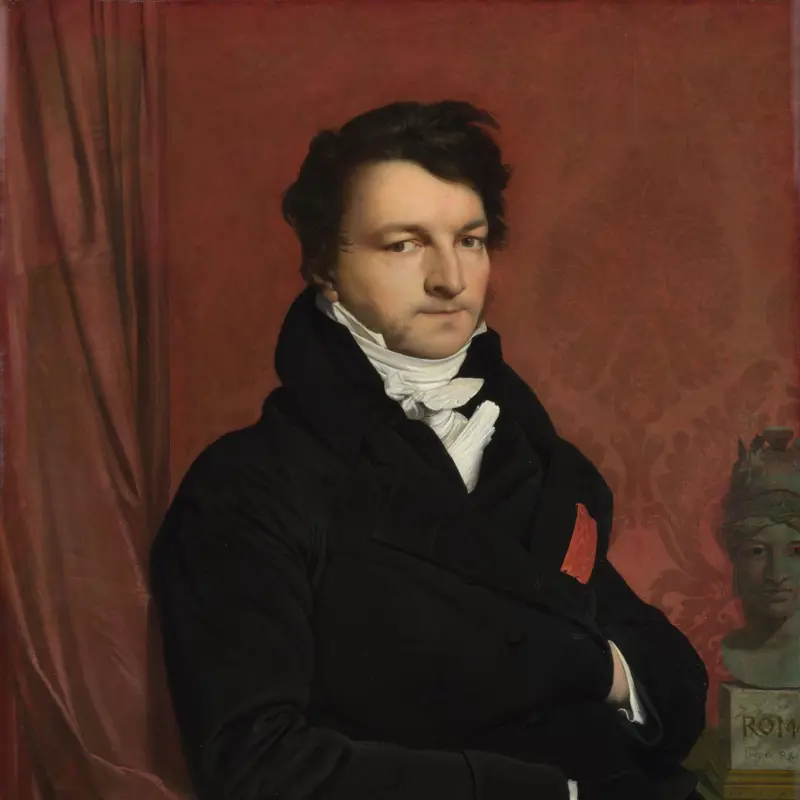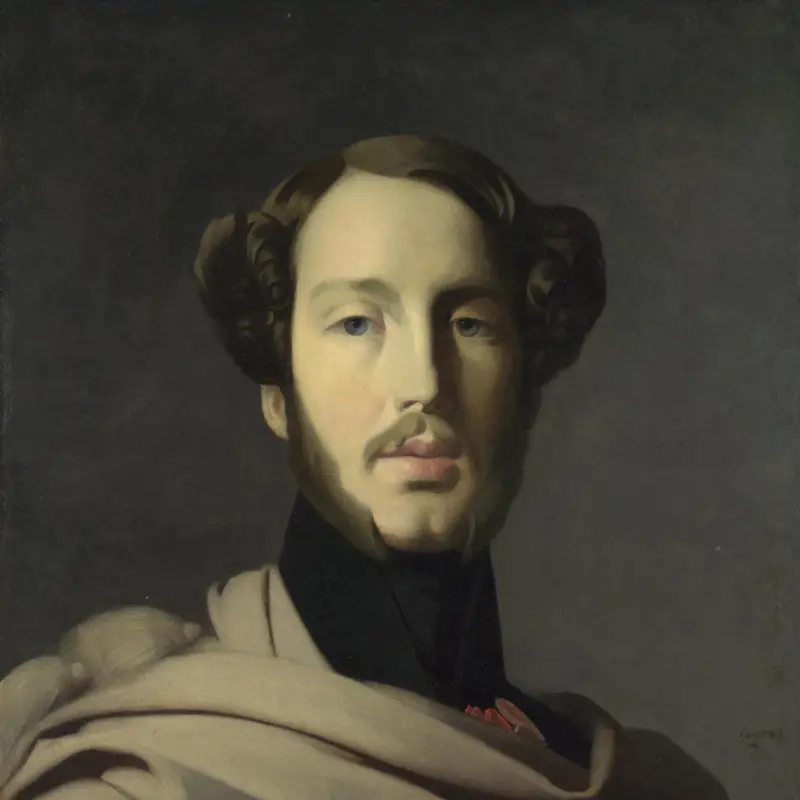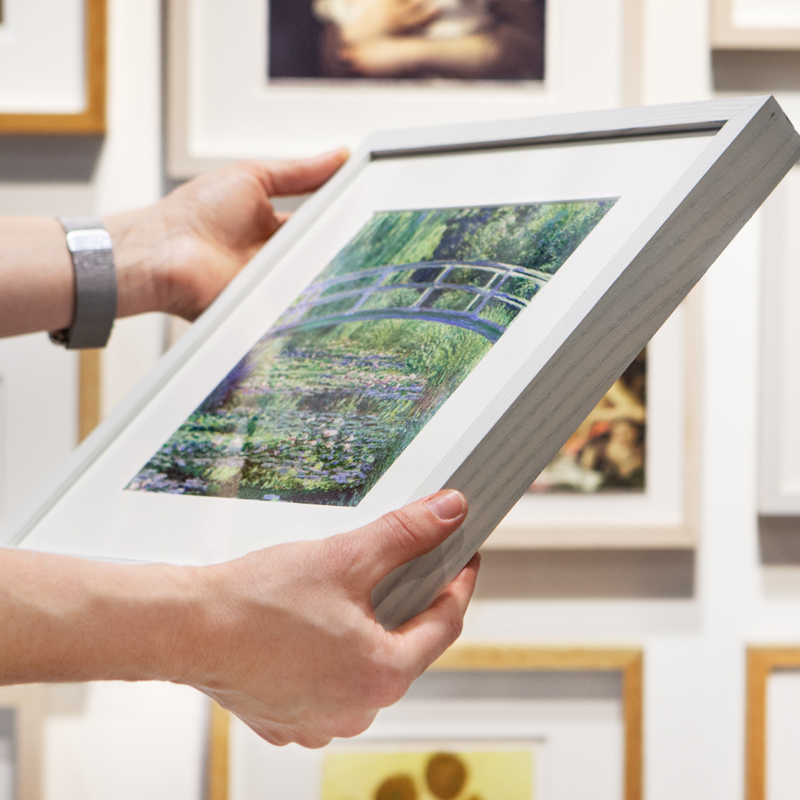Jean-Auguste-Dominique Ingres, 'Madame Moitessier', 1856
About the work
Overview
Wearing her finest clothes and jewellery, Madame Moitessier gazes majestically at us. She is the embodiment of luxury and style during the Second Empire, which saw the restoration of the French imperial throne and the extravagant display of wealth. Her distinctive pose is based upon a Roman wall painting from Herculaneum depicting the goddess of Arcadia.
The portrait was commissioned in 1844 to celebrate the marriage two years earlier of Marie Clotilde-Inès de Foucauld to the wealthy merchant, Sigisbert Moitessier. Ingres was initially reluctant to accept the commission, but changed his mind after meeting the 23-year-old Madame Moitessier, whom he described as ‘beautiful and good’. Nonetheless, it took him 12 years to complete the painting. During this time, the picture underwent several major revisions: a young daughter, Catherine, was originally to be included but was removed from the composition, and a different dress was chosen to reflect the change in fashion.
Audio description
Listen to an audio description of Jean-Auguste-Dominique Ingres's 'Madame Moitessier'
Transcript
This is a description of the portrait of 'Madame Moitessier' by Jean-Auguste-Dominique Ingres which was completed in 1856. It is oil on canvas, 120cm high and just over 92 cm wide. It still has the imposing gold frame designed by the artist, heavily embellished with gilded flowers in relief, which echo the pattern of the sitter’s dress.
The striking three-quarter portrait of Mme Moitessier almost fills the bottom two thirds of the painting. A young woman with dark hair and eyes, she is seated on a pink, damask sofa wearing a spectacular floral silk ballgown. The lowcut neckline reveals her rounded shoulders and bare arms. She looks calmly out at us from a shadowy but opulent interior.
Her wide skirt which covers her feet, narrows towards her corseted waist, the bodice forming an inverted triangle as it widens to skim her shoulders. The top half of her body and the oval of her head are turned slightly to our right, but her eyes look directly at us beneath perfectly curving brows. Her pale pink lips curve with the hint of a smile and her eyes have a spark bringing her face to life. Her dark hair is parted in the centre and taken softly back from her rounded face into a white lace decoration trimmed with red ribbon. Her earlobes are revealed, which was both daring and fashionable for the time. Her left arm rests on the folds of her dress, and she holds a folded fan. Her right elbow rests on the back of the sofa, her curiously boneless looking right hand in a strange gesture, the tip of her forefinger touching her temple.
Her dress is a crinoline, the latest fashion in 1856, the skirt supported by voluminous petticoats which allow us no sense of the form of her legs beneath. The bodice is embellished with tassels and a bow with long trailing ribbons. The silvery coloured silk is patterned with flowers in blues, oranges and shades of red and pink, colours which are picked up throughout the painting, including on her fan. She has a large brooch on her bodice, and heavy bracelets on her wrists, all with huge stones in gold settings.
Light falls strongly on to her from above, making her pale skin luminous, and shadows create the rounded contours of her body. Ingres has used oil paint with such extraordinary precision it is hard to imagine it’s paint at all, the brushmarks scarcely visible.
Behind the sofa, to the left is a partial view of a red table with a golden base. On it is a tall Japanese Imari vase with a lid, patterned in shades of blue and orange. Propped against it, is a hand held fire screen with a slim, pale handle.
On the wall behind the sofa hangs a mirror, the muted reflection showing a partly open door, as well as the headdress on the back of Madame Moitessier’s head. However, it seems odd that her face is reflected in profile, which should not be possible given her position in relation to the mirror.
By the time Ingres was introduced to the 23 year old Ines Moitessier he was in his mid 60’s, the most famous and in demand French painter of his day. He and Madame Moitessier seem to have established an unlikely rapport, he referring to her often as ‘belle et bonne’, beautiful and good.
However the portrait took 12 years to complete, delayed partly by the birth of her second daughter, and also by the sickness and death of Ingres’s wife which left him devastated. The painting therefore evolved slowly and Madame Moitessier’s face has a strangely timeless quality. He did not paint her in situ which may account for the anomalies, including a tiny little figure of Cupid which tops the back of the sofa, mysteriously missing from the reflection in the mirror.
Yet Ingres shows he is capable of incredible technical and compositional complexity, conveying the presence of Madame Moitesssier with almost startling clarity.
Key facts
Details
- Full title
- Madame Moitessier
- Artist dates
- 1780 - 1867
- Date made
- 1856
- Medium and support
- Oil on canvas
- Dimensions
- 120 × 92.1 cm
- Inscription summary
- Signed; Dated and inscribed
- Acquisition credit
- Bought, 1936
- Inventory number
- NG4821
- Location
- Room 38
- Collection
- Main Collection
- Frame
- 19th-century French Frame (original frame)
Provenance
Additional information
Text extracted from the ‘Provenance’ section of the catalogue entry in Martin Davies, with additions and some revisions by Cecil Gould, ‘National Gallery Catalogues: French School: Early 19th Century, Impressionists, Post-Impressionists, etc.’, London 1970; for further information, see the full catalogue entry.
Exhibition history
-
2008Picasso et les MaîtresGaleries Nationales du Grand Palais8 October 2008 - 2 February 2009
-
2012Seduced by Art: Photography Past and PresentThe National Gallery (London)31 October 2012 - 20 January 2013
-
2015IngresMuseo Nacional del Prado24 November 2015 - 27 March 2016
-
2016The Spectacular Second Empire, 1852-1870Musée d'Orsay26 September 2016 - 16 January 2017
-
2019Cindy ShermanNational Portrait Gallery (London)27 June 2019 - 15 September 2019
-
2022Picasso Ingres: Face to FaceThe National Gallery (London)3 June 2022 - 9 October 2022Norton Simon Art Foundation21 October 2022 - 30 January 2023
Bibliography
-
1852A. Galimard, 'Un portrait par M. Ingres', Revue des beaux-arts, 1852, pp. 49-50
-
1867École nationale supérieure des beaux-arts, Catalogue des tableaux, études peintes, dessins et croquis de J.-A.-D. Ingres, Paris 1867
-
1868C. Blanc, 'Ingres, sa vie et ses ouvrages', Gazette des beaux-arts, XXV, 1868, pp. 525-45
-
1870H. Delaborde, Ingres: Sa Vie, ses travaux, sa doctrine, Paris 1870
-
1877'Tribunal Civil: M. Ingres et le portrait de Mme Moitessier', Chronique des Arts et de la Curiosité, 1877
-
1909A. Boyer d'Agen, Ingres d'après une correspondance inédite, Paris 1909
-
1911H. Lapauze, Ingres: Sa vie et son oeuvre (1780-1867), Paris 1911
-
1921H. Lapauze, Exposition Ingres, Paris 1921
-
1936M. Davies, 'A Portrait by the Aged Ingres', The Burlington Magazine, LXVIII/399, 1936, pp. 257-68
-
1937National Gallery, National Gallery and Tate Gallery Directors' Reports, 1936, London 1937
-
1942E.S. King, 'Ingres as Classicist', Journal of the Walters Art Gallery, V, 1942, pp. 68-113
-
1946Martin Davies, National Gallery Catalogues: French School, London 1946
-
1950J. Alazard, Ingres et l'Ingrisme, Paris 1950
-
1954G. Wildenstein, The Paintings of J. A. D. Ingres, London 1954
-
1957Martin Davies, National Gallery Catalogues: French School, 2nd edn (revised), London 1957
-
1957A. Mongan, 'Ingres et Mme Moitessier', Bulletin du Musée d'Ingres, 2, 1957, pp. 3-8
-
1957H. Naef, 'Monsieur Ingres et ses muses', L'Oeil, 1957
-
1965A. Mongan, 'A Portrait Drawing by Ingres', Worcester Art Museum News Bulletin and Calendar: Bulletin du Musée d'Ingres, 1965
-
1967R. Rosenblum, Jean-Auguste-Dominique Ingres, New York 1967
-
1967L. Duclaux et al., Ingres (exh. cat. Petit Palais, 27 October 1967 - 29 January 1968), Paris 1967
-
1969H. Naef, 'New Material on Ingres's Portraits of Mme Moitessier', The Burlington Magazine, CXI/792, 1969, pp. 149-50
-
1970Davies, Martin, and Cecil Gould, National Gallery Catalogues: French School: Early 19th Century, Impressionists, Post-Impressionists etc., London 1970
-
1971K. Clark, 'Ingres: Peintre de la vie moderne', Apollo, XCIII, 1971, pp. 361-4
-
1977H. Naef, Die Bildniszeichnungen von J. A. D. Ingres, Bern 1977
-
1977J. Whiteley, Ingres, London 1977
-
1977M. Wilson, Madame Moitessier by Ingres (exh. cat., National Gallery, 26 January 1977 - 20 March 1977), Painting in Focus 7, London 1977
-
1980G. Picon, Jean-Auguste-Dominique Ingres, London 1980
-
1980D. Ternois and E. Camesasca, Tout l'oeuvre peint d'Ingres, Paris 1980
-
1988J.S. Boggs et al., Degas (exh. cat. Galeries Nationales du Grand Palais, 9 February - 16 May 1988; National Gallery of Canada, 6 June - 28 August 1988; Metropolitan Museum of Art, 27 September 1988 - 8 January 1989), New York 1988
-
1990G. Vigne, 'Les fonds de portraits d'Ingres. Le décor du "Portrait de Madame Moitessier assise" d'Ingres', Bulletin du Musée Ingres, 63-64, 1990, pp. 28-31
-
1992P. Fresnault-Deruelle, 'Le mode congédié', Impressions du Musée Granet, VIII, 1992, pp. 16-20
-
1995U. Fleckner, Abbild und Abstraktion: Die Kunst des Porträts im Werk von Jean-Auguste-Dominique Ingres, Mainz 1995
-
1995C. Ockman, Ingres's Eroticized Bodies: Retracing the Serpentine Line, New Haven 1995
-
1995G. Vigne, Ingres, Paris 1995
-
1996P. Mitchell, Frameworks: Form, Function and Ornament in European Portrait Frames, London 1996
-
1996P. Mitchell and L. Roberts, A History of European Picture Frames, London 1996
-
1997A. Dumas et al., The Private Collection of Edgar Degas (exh. cat. Metropolitan Museum of Art, 1 October 1997 - 11 January 1998), New York 1997
-
1999A. Ribeiro, Ingres in Fashion: Representations of Dress and Appearance in Ingres's Images of Women, New Haven 1999
-
1999G. Tinterow and P. Conisbee, Portraits by Ingres: Image of an Epoch (exh. cat. The National Gallery, 27 January - 25 April 1999; National Gallery of Art, Washington, 23 May - 22 August 1999; Metropolitan Museum of Art, 28 September 1999 - 2 January 2000), London 1999
-
2000U. Fleckner, Jean-Auguste-Dominique Ingres, 1780-1867, Cologne 2000
-
2000A. Rifkin, Ingres Then, and Now, New York 2000
-
2000S. Betzer, 'Ingres's Second "Madame Moitessier": "Le Brevet du Peintre d'Histoire"', Art History, XXIII/5, 2000, pp. 681-705, 818
-
2001
C. Baker and T. Henry, The National Gallery: Complete Illustrated Catalogue, London 2001
-
2001D. Ternois, 'Lettres d'Ingres à Marcotte d'Argenteuil. Dictionnaire', Archives de l'art Français, XXXVI, 2001, pp. 1-330
-
2005D. Ternois and M.-J. Ternois, Lettres d'Ingres à Gilibert, Paris 2005
-
2005M. Fend, 'Bodily and Pictorial Surfaces: Skin in French Art and Medicine, 1790-1860', Art History, XXVIII/3, 2005, pp. 311-39
-
2006V. Pomarède, Ingres: 1780-1867 (exh. cat. Musée du Louvre, 24 February 2006 - 15 May 2006), Paris 2006
About this record
If you know more about this work or have spotted an error, please contact us. Please note that exhibition histories are listed from 2009 onwards. Bibliographies may not be complete; more comprehensive information is available in the National Gallery Library.






